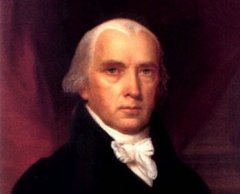The following is excerpted form the Drudge Report.What is interesting is the number of items Madison wanted .In the following I have take liberty to highlight in red certain passages.Read the following and see how it might have or would have reigned in today's politicians.
The following is excerpted from the Drudge Report.
Five items Congress deleted from Madison’s original Bill of Rights
As Constitution Daily counts down to Bill of Rights Day on December 15, we are looking at some fascinating facts about the iconic document.
When James Madison spoke to the
First Congress he proposed 20 amendments for a Bill of Rights, and not
the 10 we all know about. So what did Congress delete from the final
list that was ratified by the states?
There
were some very significant deletions as his proposed list went through
the House and Senate, and Madison himself took part in the decisions to
edit out some of his own ideas.
In the end, 12 of the 20
amendments survived the congressional approval process. Enough states
approved 10 of those 12 amendments to make the Bill of Rights a reality
on December 15, 1791. One of two bypassed amendments was eventually
ratified in 1992 as the 27th
Amendment; it restricted the ability of Congress to change its pay
while in session. (The other proposed amendment dealt with the number of
representatives in Congress, based on the 1789 population.)
But if Madison had his original
way, our Constitution would have a two-part Preamble that includes part
of Thomas Jefferson’s Declaration of Independence before the current
preamble.
On June 8, 1789, Madison told Congress the Preamble needed a “pre-Preamble.”
“First. That there be prefixed to
the Constitution a declaration, that all power is originally vested in,
and consequently derived from, the people.
That Government is instituted and
ought to be exercised for the benefit of the people; which consists in
the enjoyment of life and liberty, with the right of acquiring and using
property, and generally of pursuing and obtaining happiness and safety.
That the people have an
indubitable, unalienable, and indefeasible right to reform or change
their Government, whenever it be found adverse or inadequate to the
purposes of its institution.”
In essence, Madison wanted to
bury arguably the most famous sentence in American history, “We the
People,” in the middle of a combined Preamble. (The desires of the Tea Party)
Roger Sherman of Connecticut was among the first to question the move to downplay “We the People.”
“The truth is better asserted
than it can be by any words what so ever. The words ‘We the People’ in
the original Constitution are as copious and expressive as possible,” he
said. And in time, Congress deleted the entire “pre-Preamble” as the
Bill of Rights went through committees. (Sounds like the actions of today's RINO)
Another item that Madison
proposed was making sure at least three of the liberties guaranteed in
the Bill of Rights applied to all states.
“No State shall violate the equal
rights of conscience, or the freedom of the press, or the trial by jury
in criminal cases,” Madison said in the fifth part of his original Bill
of Rights proposal.
The selective incorporation of parts of the Bill of Rights to the states didn’t happen until the early part of the 20th century as the Supreme Court interpreted the 14th Amendment’s Due Process Clause in a series of cases.
Madison also wanted to clearly spell out that each branch of government had clear, distinct roles.
“The powers delegated by this
Constitution are appropriated to the departments to which they are
respectively distributed: so that the Legislative Department shall never
exercise the powers vested in the Executive or Judicial, nor the
Executive exercise the powers vested in the Legislative or Judicial, nor
the Judicial exercise the powers vested in the Legislative or Executive
Departments,” he said in the last part of his proposed Bill of Rights.
Neither of these items made it
through the congressional review process. But Madison felt strongly
enough about the separation of powers clause that he wanted it as the
new Article VII in the Constitution.
And the second part of the new
“Article VII” did survive in the Bill of Rights. It read, “The powers
not delegated by this Constitution, nor prohibited by it to the States,
are reserved to the States respectively.”
Another interesting twist in Madison’s proposed Bill of Rights was a different version of what became the Second Amendment.
“The right of the people to keep
and bear arms shall not be infringed; a well armed and well regulated
militia being the best security of a free country: but no person
religiously scrupulous of bearing arms shall be compelled to render
military service in person,” said Madison. (However we did have the Conscientious Objectors)
And the final, big difference
that Madison wanted was the entire Bill of Rights interwoven within the
Constitution, and not appended at the document’s end.
That idea didn’t pass muster with
Congress because there were concerns of an appearance that the
Constitution was being rewritten. Madison dropped his support of
“interweaving” the amendments during the House debate about moving his
already amended Bill of Rights to the Senate.
In the end, many of the core ideas introduced by Madison in June 1789 made it into the ratified version of the Bill of Rights.
“I think we should obtain the
confidence of our fellow citizens, in proportion as we fortify the
rights of the people against the encroachments of the government,”
Madison said in his address to Congress.



No comments:
Post a Comment